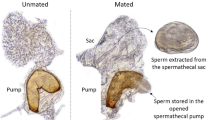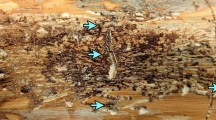Abstract
The spruce bark beetle, Ips typographus, is one of the most extensively studied European forest pests. Gaps exist in the knowledge about second generation breeding performance in bivoltine populations. In this study, the breeding performance of the second generation was evaluated in three bivoltine populations of I. typographus in the SE Alps. Length of the maternal galleries (from 40.5 to 44.8 mm), population growth rate (PGR; from 0.7 to 3.6), and emerged adults per m2 (from 669 to 1,570 insects/m2) varied among populations and were negatively correlated with bark colonisation density. Pheromone traps set up in the three investigated forests differed in the number of trapped beetles, with mean captures ranging between 5,310 and 19,850 insects per trap. The populations giving the highest captures in the traps showed the lowest bark colonisation density (248 vs. 489 maternal galleries per m2) and the best breeding performance. The populations of parasitoids and predators corresponded to just 1–9 and 2–10% of the emerging I. typographus adults, respectively, and phloem temperature never reached thresholds lethal to I. typographus. Interspecific competition was negligible, whereas intraspecific competition was found to be the main factor affecting the breeding performance of the second generation, although with different intensity according to the colonisation density. It is hypothesised that competition with the first generation and spring precipitation influence the number of suitable hosts available to the second generation.




Similar content being viewed by others
References
Anderbrant O (1990) Gallery construction and oviposition of the bark beetle Ips typographus (Coleoptera: Scolytidae) at different breeding densities. Ecol Entomol 15:1–8
Anderbrant O, Schlyter F, Birgersson G (1985) Intraspecific competition affecting parents and offspring in the bark beetle Ips typographus. Oikos 45:89–98
Annila E (1969) Influence of the temperature upon the development and voltinism of Ips typographus L. (Coleoptera, Scolytidae). Ann Zool Fenn 6:161–207
Baier P, Pennerstorfer J, Schopf A (2007) PHENIPS—a comprehensive phenology model of Ips typographus (L.) (Col., Scolytinae) as a tool for hazard rating of bark beetle infestation. For Ecol Manag 249:171–186
Berg EE, Henry JD, Fastie CL, DeVolder AD, Matsuoka SM (2006) Spruce beetle outbreaks on the Kenai Peninsula, Alaska, and Kluane National Park and Reserve, Yukon Territory: relationship to summer temperatures and regional differences in disturbance regimes. For Ecol Manag 227:219–232
Chararas C (1962) Etude biologique des Scolytides des Conifères. Lechevalier, Paris, France
Christiansen E, Bakke A (1988) The spruce bark beetle of Eurasia. In: Berryman AA (ed) Dynamics of forest insect populations. Patterns, causes, implications. Plenum Press, New York, pp 479–503
Dobbertin M, Wermelinger B, Bigler C, Bürgi M, Carron M, Forster B, Gimmi U, Rigling A (2007) Linking increasing drought stress to Scots pine mortality and bark beetle infestations. Sc World J 7:231–239
Eck R (1990) The parasitic hymenoptera associated with Ips typographus in the period of progradation: spectrum of species and mortality rates by parasites in some forests of the former G.D.R. East Germany (Insecta Hymenoptera Braconidae Chalcicoidea). Entomol Abhand (Dresden) 53:151–178
Faccoli M (2009) Effect of weather on Ips typographus (Coleoptera Curculionidae) phenology, voltinism and associated spruce mortality in the South-Eastern Alps. Env Entomol 38:307–316
Faccoli M, Stergulc F (1999) Monitoring of Ips typographus (L.) by pheromone traps and trap-trees in Southern Italian Alps. In: Forster B, Knìzek M, Grozki W (eds) Methodology of forest insects and disease survey in central europe. Sion-Châteauneuf, Switzerland, pp 242–243
Faccoli M, Stergulc F (2004) Ips typographus (L.) pheromone trapping in south Alps: spring catches determine damage thresholds. J Appl Entomol 128:307–311
Faccoli M, Stergulc F (2006) A practical method for predicting the short-time trend of bivoltine populations of Ips typographus (L.) (Col., Scolytidae). J Appl Entomol 130:61–66
Faccoli M, Stergulc F (2008) Damage reduction and performance of mass trapping devices for forest protection against the spruce bark beetle, Ips typographus (Coleoptera Curculionidae Scolytinae). Ann For Sci 65(3):309
Furuta K (1989) A comparison of endemic and epidemic populations of the spruce beetle (Ips typographus japonicus Niijima) in Hokkaido. J Appl Entomol 107:289–295
Grégoire J-C, Evans HF (2004) Damage and control of BAWBILT organisms–an overview. In: Lieutier F, Day KR, Battisti A, Grégoire J-C, Evans HF (eds) Bark and wood boring insects in living trees in europe, a synthesis. Kluwer Academic Publishers, London, pp 19–37
Hansen EM, Bentz BJ (2003) Comparison of reproductive capacity among univoltine, semivoltine, and re-emerged parent spruce beetles (Coleoptera: Scolytidae). Can Entomol 135:697–712
Harding S, Ravn H (1985) Seasonal activity of Ips typographus in Denmark. Z Ang Entomol 99:123–131
Jönsson AM, Harding S, Bärring L, Ravn HP (2007) Impact of climate change on the population dynamics of Ips typographus in southern Sweden. Agr For Meteorol 146:70–81
Jönsson AM, Appelberg G, Harding S, Bärring L (2009) Spatio-temporal impact of climate change on the activity and voltinism of the spruce bark beetle, Ips typographus. Glob Change Biol 15:486–499
Kenis M, Wermelinger B, Grégoire J-C (2004) Research on parasitoids and predators of Scolytidae in living trees in Europe—a review. In: Lieutier F, Day KR, Battisti A, Grégoire J-C, Evans HF (eds) Bark and wood boring insects in living trees in Europe, a synthesis. Kluwer Academic Publishers, London (UK), pp 237–290
Kreutz J, Zimmermann G, Vaupel O (2004) Horizontal transmission of the entomopathogenic fungus Beauveria bassiana among the spruce bark beetle. Ips typographus (Col., Scolytidae) in the laboratory and under field conditions. Biocontrol Sci Technol 14:837–848
Kruger K, Mills NJ (1990) Observation on the biology of three parasitoids of the spruce bark beetle Ips typographus (Col., Scolytidae): Coeloides bostrychorum, Dendrosoter middendorfii (Hym., Braconidae) and Rhopalicus tutela (Hym., Pteromalidae). J Appl Entomol 110:281–291
Lange H, Økland B, Krokene P (2006) Thresholds in the life cycle of the spruce bark beetle under climate change. InterJournal Complex Syst 1648:1–10
Lawson SA, Furuta K, Katagiri K (1997) Effect of natural enemy exclusion on mortality of Ips typographus japonicus Niijima (Col., Scolytidae) in Hokkaido, Japan. J Appl Entomol 121:89–98
Lindelow Å, Schröeder M (2001) Spruce bark beetle. Ips typographus (L.), in Sweden: monitoring and risk assessment. J For Sci 47:40–42
Martinek V (1956) Beitrag zur Erklärung des Problems der Geschwisterbrut beim Fichtenborkenkäfer Ips typographus (L.). Sbornìk Československé Akademie Zemědělskych Věd. Lesnictvi 29:615–644
Mawby WD, Hain FP, Doggett CA (1989) Endemic and epidemic populations of southern pine beetle: Implications of the two-phase model for forest managers. For Sci 35:1075–1087
Mills NJ (1986) A preliminary analysis of the dynamics of within tree populations of Ips typographus (L.) (Coleoptera Scolytidae). J Appl Entomol 102:402–416
Nebe W (1968) Über die Beziehungen zwischen Klima und Wachstum der Fichte (Picea abies) in ihrem europäischen Verbreitungsgebiet. Archiv für Forstwesen 17:1219–1238
Netherer S, Pennerstorfer S (2001) Parameters relevant for modelling the potential development of Ips typographus (Coleoptera: Scolytidae). Integr Pest Manag Rev 6:177–184
Ogibin BN (1973) Effect of colonization density on the fertility of Ips typographus L. Ekologiya 5:66–72
Raffa KF, Aukema BH, Bentz BJ, Carroll AL, Hicke JA, Turner MG, Romme WH (2008) Cross-scale drivers of natural disturbances prone to anthropogenic amplification: the dynamics of bark beetle eruptions. Bioscience 58:501–517
Sauvard D (2004) General biology of bark beetles. In: Lieutier F, Day KR, Battisti A, Grégoire J-C, Evans HF (eds) Bark and wood boring insects in living trees in europe, a synthesis. Kluwer Academic Publishers, London, pp 63–88
Schlyter P, Stjernquist I, Barring L, Jönsson AM, Nilsson C (2006) Assessment of the impacts of climate change and weather extremes on boreal forests in northern Europe, focusing on Norway spruce. Climate Res 31:75–84
Schröeder LM (2007) Escape in space from enemies: a comparison between stands with and without enhanced densities of the spruce bark beetle. Agr For Entomol 9:85–91
Stergulc F, Faccoli M (2003) Ips typographus (L.) (Coleoptera Scolytidae) in Southeastern Alps: results of a six-year-long monitoring program. In: McManus ML, Liebhold AM (eds) Ecology, survey and management of forest insects. Technical report NE 311. USDA Forest Service, Northeastern Research Station, Krakow, Poland, pp 168–169
Thalenhorst W (1958) Grundzüge der Populationsdynamik des großen Fichtenborkenkäfers Ips typographus L. Schriftenreihe der Forstlichen Fakultät der Universität der Göttingen 21:126
Vité JP (1952) Temperaturversuche an Ips typographus (L.). Zoologischer Anzeiger 149:196–206
Wagner TL, Fargo WS, Keeley LL, Coulson RN, Cover JD (1982) Effects of sequential attack on gallery construction, oviposition and re-emergence by Dendroctonus frontalis (Coleoptera: Scolytidae). Can Entomol 114:491–502
Wermelinger B (2004) Ecology and management of the spruce bark beetle Ips typographus—a review of recent research. For Ecol Manag 202:67–82
Wermelinger B, Seifert M (1998) Analysis of temperature dependent development of the spruce bark beetle Ips typographus (L.) (Col. Scol.). J Appl Entomol 122:185–191
Weslien J (1992) The arthropod complex associated with Ips typographus (L.) (Coleoptera, Scolytidae): species composition, phenology, and impact on bark beetle productivity. Entomol Fenn 3:205–213
Weslien J, Regnander J (1990) Colonisation densities and offspring production in the bark beetle I. typographus (L.) in standing spruce trees. J Appl Entomol 109:358–366
Wittwer D, Matthews K, Zogas K, Trummer L, Holsten E, Schulz B, Hennon P, Schultz M, Riggs J, Burnside R (1998) Forest insect and disease conditions in alaska, 1998. General Technical Report US Forest Service R10-TP-74
Zar JH (1999) Biostatistical analysis. Prentice Hall Press, Upper Saddle River
Acknowledgements
The authors would like to thank Fabio Stergulc, Olle Anderbrant, Andrea Battisti, Marc Kenis and two anonymous referees for their constructive comments on earlier versions of the manuscript, and to Alison Garside for linguistic proofreading. Special thanks go to Massimo Stroppa and the foresters of the Forest Centre of Pinzano al Tagliamento and Pontebba for their help and assistance during field experiments. We are grateful to Marc Kenis and K. van Achterberg who identified parasitoids. The research was partially supported by the project “BAUSINVE”—Direzione Centrale delle Risorse Agricole, Naturali, Forestali e della Montagna—Regione Autonoma Friuli—Venezia Giulia (Italy), and by the PRIN project, prot. 200774ENMR: “Climatic change and Italian pine pests: a model study”.
Author information
Authors and Affiliations
Corresponding author
Additional information
Communicated by C. Stauffer
Rights and permissions
About this article
Cite this article
Faccoli, M., Bernardinelli, I. Breeding performance of the second generation in some bivoltine populations of Ips typographus (Coleoptera Curculionidae) in the south-eastern Alps. J Pest Sci 84, 15–23 (2011). https://doi.org/10.1007/s10340-010-0320-7
Received:
Accepted:
Published:
Issue Date:
DOI: https://doi.org/10.1007/s10340-010-0320-7




